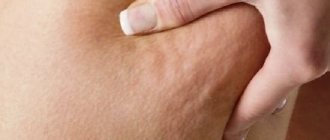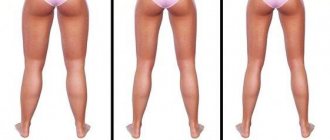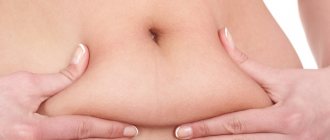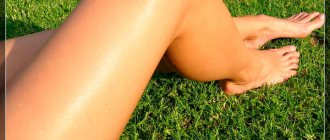It's no secret that most of us would give a lot to have a flat, toned stomach. Every day we watch famous models and film actresses on TV, and every day we understand that the fat pad on the stomach is not the sign by which men evaluate a woman’s sexuality. And then, stubbornly pursing our lips, we decide to achieve the ideal figure parameters at all costs and make our stomach slim and toned. What are we doing for this? First, we try to stop eating, then we work out our abs until we lose consciousness, or we spend our last money on “magic” creams and ointments that promise to solve the problem. But for some reason, the hanging tummy doesn’t even think about leaving. What's the matter? Is there really a secret way to remove belly fat that is not available to mere mortals?
If there was a secret technique with which you could instantly lose belly fat, it would probably cost a lot of money. But there are no secrets here - you can remove belly fat only by changing your own lifestyle, leaving aside bad habits. For many girls and women, this is a very boring and uninteresting way that requires constant work on oneself. However, it is he who helps all those slender girls who flaunt their perfect abs in front of us from TV screens to always stay in great shape.
Belly fat: is it really that bad?
First, let's think about why most women accumulate large amounts of fat in their lower abdomen. Is it just an inactive lifestyle and love for high-calorie foods that is to blame? After all, for centuries, the world's greatest artists have glorified the beauty of the naked body, carefully drawing out the pretty curves just below the navel. And it never occurred to anyone to fight this “scourge,” considering this state of affairs completely normal. Perhaps the modern desire for a flat stomach is just something wrong, completely inconsistent with the nature of the female body?
Indeed, there is a rational grain in this thought. A woman is a continuator of the family; her body must be ready to bear and feed a child. From time immemorial, men chose as wives girls with a strong body, wide hips - these are the ones who are capable of giving birth to a whole bunch of children (and then they gave birth not to one or two, as now, but ten to twelve - and this was normal). Fat reserves were simply necessary in case of unexpected hunger; it helped to mobilize strength to fight diseases and accumulate energy for breastfeeding. Just a couple of hundred years ago, few men dreaming of healthy offspring would have thought of choosing as their companion a girl with a belly stuck to her spine.
Another thing is our time. Nowadays, young people are increasingly less likely to look at ruddy, strong donuts, preferring subtly thin, thin girls. Fat on the stomach and thighs has become a real curse for all those women who do not find time for sports and healthy eating. However, not all of the male population of the planet is so picky about soft ladies’ bellies. On the eastern continent, good-quality female bodies with wide hips and waists are still at a premium, and in a number of African countries, future brides are specially fattened up before the wedding - otherwise they may end up without a husband.
Not long ago, world-renowned professor of microbiology and immunology Makio Iwashima proved an absolutely shocking fact: belly fat helps regulate the human immune system. The fact is that the cells of the omentum (the so-called storage of adipose tissue) secrete a substance that activates our immunity and plays a very important role in the regeneration of damaged tissue. So, recently, many doctors insist that belly fat is not harmful, but a huge health benefit!
But this doesn’t make it any easier for all those numerous girls and women who want to be slim, sexy and attractive to the opposite sex. Be that as it may, a flat stomach is an established stereotype of female attractiveness of our time. Therefore, we will give some valuable tips on how to quickly and effectively remove excess fat from your belly without harming your own health.
How to properly deal with belly fat
Many girls who decide to remove fat from the lower abdomen make the same mistake: they tirelessly pump up their abs without changing their diet or giving up bad habits. For a week now, my abdominal muscles have been aching, every step causes pain, and the nasty fat still refuses to go away! Why? Let us tell you one little secret: our body itself decides in which part of the body fat is needed and in which it is not. If after prolonged physical activity your fat pad remains in place, it means that your body fundamentally disagrees with your ideas about beauty. It is quite possible that you will lose weight, but not in the abdominal area, but, say, in the legs or chest.
Did you know that even safely removed fat does not leave you forever - it returns, but in a completely different place? So, after liposuction - this is a procedure for mechanical suction of fat through a special tube - the entire volume of pumped out fat returns, but upward - to the area of the arms, shoulders, and chest. This is a scientific medical fact recorded by scientists who observed thirty-two women who had liposuction for six months. Conclusion? Mother Nature does not let herself be deceived, and the body carefully controls the number of its favorite fat cells. As soon as one cell is destroyed, the body immediately creates another.
But don’t get upset and give up: if there weren’t a way to remove excess belly fat, you would never see rows of slender beauties proudly walking along the catwalk. After all, they somehow managed to do it? So it will work for you too. But you shouldn’t count on easy ways and immediate results: a flat, elastic stomach is the result of constant work on yourself. Once you relax a little, you will have to start all over again.
Balanced nutrition as a lifestyle
The first thing girls who dream of a flat stomach prefer to do is go on a strict diet. This is how they expect to gain a model figure and a perfectly flat, elastic stomach in the shortest possible time. We hasten to disappoint you, such a decision is unlikely to benefit you. Now we will not tell you about the harm to your health that you can cause to yourself - a sick stomach and prolonged depression are familiar to many extreme athletes who are losing weight. The thing is that such diets help you lose weight by depriving your body of water, and not fat at all. If you lose at least twenty kilograms in this way, your hanging fat belly will not go away (of course, it will shrink, but you still won’t get flat abs).
In fact, in order to lose belly fat, you just need to stop overeating by calculating the number of calories you consume daily. The danger is not in the pasta and cutlets, but in their quantity. So how to remove fat from the lower abdomen? It’s just that moderation is necessary in everything, then even seemingly fatty food will not cause any harm to your figure. Try to eat more foods containing fiber - vegetables, fruits, whole grains. In order to digest such food, the body requires much more energy - it draws it from unspent reserves in the form of fat on your stomach and waist.
How to cure a wen
The first thing you need to know is that treatment and removal of wen at home is strictly unacceptable! Some people try to puncture the wen or squeeze it out like a regular pimple. Such manipulations can lead to infection and the spread of tumors throughout the body.
You should not trust yourself and traditional medicine. Folk “craftsmen” have come up with many techniques, most of which are not only ineffective, but can also be harmful to health. For example, the myth that lipomas will disappear after a person loses weight. Exhaustive diets do not save you from this disease at all! They will only weaken your body’s defenses, and this will definitely not be beneficial and will not enhance the treatment.
Before prescribing treatment, the doctor will examine the lipoma. If the formation is small, then a puncture is made, and the liquid that is inside is examined. If the lump has grown, then you may be sent for an ultrasound to see what has accumulated inside the lump.
Wen is removed quite simply by standard surgery. The operation lasts approximately 1-2 hours, and complete healing of the operated area takes about 2 weeks. Small tumors are removed under local anesthesia, while large ones are removed under general anesthesia. The doctor must not only remove the fatty tissue, but also remove the lipoma capsule. If this is not done, there is a possibility that after some time a tumor will form in that place again.
In not very advanced cases of the disease, the doctor may prescribe treatment that does not include surgical intervention. This treatment involves the injection of a special drug into the wen, which “resolves” the adipose tissue. But the disadvantage of this method is that the result can be noticed only after a couple of months, and the lipoma capsule is not removed and the risk of recurrence of the disease remains.
Over time, new non-surgical and minimally invasive methods for removing wen began to appear in the arsenal of doctors. Particularly popular are: laser, puncture-aspiration, radio wave methods. The latter method is effective for small formations. Laser is a panacea for any wen. Due to the fact that the laser beam is very thin, it has become possible to remove lipomas on the face without leaving scars. A laser wound on the body heals much faster – in 4-5 days. The operation itself is painless and bloodless, which is important for many people. Another advantage is that the operated patient does not require stitches or hospitalization. After removal of fatty tissues using the laser method, there are no relapses.
Don’t neglect your health and take timely measures if you find even minor symptoms of the disease! Timely treatment will save you from many unpleasant consequences that can arise due to an indifferent attitude towards your health.
Structure and functions of adipose tissue. Types of adipose tissue
Adipose tissue is formed from preadipocytes. The main function of adipose tissue is to store energy in the form of lipids, as well as to insulate other body tissues from environmental influences, such as cold, heat and other factors. Adipose tissue has in recent years been recognized by medical professionals as a major endocrine organ because it influences the production of hormones such as leptin, estrogen and cytokine. In addition, subcutaneous and other fat can affect all internal organs without exception. Excessive amounts of fat, both subcutaneous and contained on the surface of internal organs, lead to the development of many diseases.
Two types of adipose tissue
There are two types of adipose tissue: white and brown fat. The latter is a generator of body heat. The formation of adipose tissue is controlled in part by the "fat" gene, which was first identified by the Swiss naturalist Gesner in 1551.
Anatomical features
In the human body, adipose tissue is located under the skin (subcutaneous fat), around internal organs (visceral fat), in the bone marrow (yellow bone marrow), in the intermuscular space (muscular system) and in the breast tissue of women and men. Adipose tissue is located in certain places; these areas of the body are called “fat depots”.
In addition to adipocytes, the percentage of which is very high in adipose tissue, other cells are also present, for example, stromal vascular fractions. They contain preadipocytes, fibroblasts, macrophages and endothelial cells. Adipose tissue also contains many small blood vessels. In the integumentary system, that is, in the skin, fat accumulates in the subcutaneous layer, providing a person with insulation from heat and cold. The space around the organs also contains a small amount of fat, which is necessary to protect against vibration, shock, etc.
The main function of adipose tissue is to provide a supply of lipids that can be burned to meet the body's energy needs. Lipids protect humans from excess glucose by storing triglycerides produced by the liver from sugars. Some evidence suggests that most of the lipids synthesized from carbohydrates are located in the adipose tissue itself. Fat depots in different parts of the body have different biochemical profiles. Under normal environmental and health conditions, they provide feedback between the feeling of hunger and the transmission of these impulses to the brain.
Why is internal fat worse than subcutaneous fat?
When visceral fat develops in a person who is not overweight, it almost does not appear externally, but envelops the insides - the heart, liver, and intestines literally float in fat. This is a dangerous condition. Firstly, internal organs and blood vessels are compressed, blood circulation is disrupted, and heart function worsens. Normal tissues are gradually replaced by fatty tissue. For example, in the case of fatty hepatosis. The risks of heart attack, stroke, and heart failure increase.
Secondly, visceral obesity is fraught with the development of metabolic syndrome. In this condition, the sensitivity of cells to insulin decreases, which leads to type II diabetes and an increase in “bad” cholesterol in the blood.
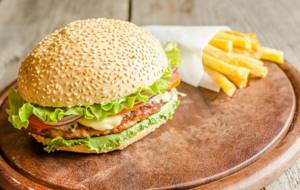
Fat pads: causes, types, symptoms, treatment
Fat pads are the common name for a condition also known as Hoffa syndrome. With this disease, adipose tissue is pinched below the kneecap area. The fat pad in this area of the leg is designed to protect the kneecap from injury.
Fat pads are also sometimes mistakenly called fat deposits in the buttocks and thighs. The unofficial name for such deposits is “ears.” However, “ears” on the hips are more likely to be the consequences of poor nutrition than to diseases that truly threaten the life and health of the patient.
The fat pad at the bottom of the kneecap between the femur and shinbone is a dense mass of fat cells surrounded by septa of fibrous tissue. It may be abundantly supplied with capillaries and nerve endings.
Other examples of fat pads are:
- Intra-articular fat deposits covered with a layer of synovial cells. Most often it appears in the back of the elbow joint.
- Buccal fatty tissue in infants (abnormally plump cheeks).
- Fat pad on the labia.
- Heel pad. A common disease that leads to inflammation and pain. The heel is formed from the fat pad and calcaneus, so hypertrophy of this pad is a fairly common deformity resulting from injury.
- Knee.
- Popliteal.
The main reasons for the appearance of a fat pad are the following factors:
- injury;
- pressure on the kneecap area, which causes pinching of the fatty tissue between the femur and tibia;
- sports factors (systematic light blows to the knee);
- a lot of extra weight.
Symptoms of fat pad
The main symptoms of a fat pad are:
- aching, mild pain in the heel, in the middle of the foot;
- pain in the plantar area of the leg;
- pressing in the center of the foot causes pain;
- It’s uncomfortable to walk in any shoes;
- when walking barefoot on a hard surface (tiles, stones), the pain intensifies;
- redness, swelling;
- inflammation, itching;
- tingling in the swollen area;
- appearance of cyanosis;
- darkening of toenails;
- leakage of liquid at the site of damage to the pillow;
- temperature increase;
- fever.
How is the operation performed?
Surgical intervention to remove Bisha's lumps is aimed exclusively at correcting the oval of the face, however, such an operation cannot radically change the patient's appearance. As a result of such an intervention, you can smooth out the contours of the face, refresh the skin, and refine the lower part of the chin.
The surgical procedure is performed on an outpatient basis, and the method of pain relief is selected individually. The surgeon makes an incision in the area of the inner surface of the cheek and provides direct access to the fat capsules. The volume of fat removed is calculated individually and directly depends on the patient’s wishes, the desired face shape and his personal anatomical features.
With the accompanying correction of the cheekbones, fat deposits are transported higher, thereby creating additional volume in this area. This procedure in plastic surgery is called transposition of Bisha's fatty lumps. Having completed all the necessary surgical procedures, the specialist sutures the incision with a special absorbable material.
Removal of fatty lumps can also be done through incisions on the face. This technique is much more complex and traumatic than when fatty deposits are removed through incisions on the inside of the cheeks. Basically, such surgery is additional if there is any major operation in the facial area that requires incisions. They are often used not only to achieve the main goal, but also to remove Bish's lumps.
The volume of formations removed may vary, which directly depends on the cosmetic effect that the patient needs to obtain. However, in most situations, Bisha's lumps are removed completely. A specialized disinfectant pad is applied to the seams.

Don't eat sugar and avoid sweetened drinks

The only thing worse than sugar in this regard is liquid sugar. Sugary drinks are not registered by the brain in the same way as cake or candy, so a person can drink them in unlimited quantities. However, they significantly influence Effects of food form and timing of ingestion on appetite and energy intake in lean young adults and in young adults with obesity. on the total caloric intake of the diet. Sweetened drinks increase the risk of obesity in children by 60% Relation between consumption of sugar-sweetened drinks and childhood obesity: a prospective, observational analysis. .
Therefore, the first step to a flat stomach is changing your diet. Remove soda, packaged juices, and sugary sports drinks. But leave the fruits: the advantages of them outweigh the disadvantages of fructose. And, of course, read labels, as sugar may be in foods you wouldn’t expect.
Eat more protein
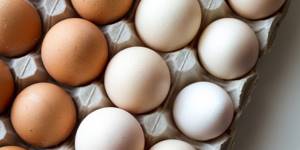
Research shows Quality protein intake is inversely related to abdominal fat. that people who eat more protein have much less belly fat. Experiments also confirm Intake of macronutrients as predictors of 5-y changes in waist circumference. reducing the risk of abdominal enlargement over the next five years.
To get the desired effect, increase the amount of protein in your diet to 25–30%. This can be done with eggs, fish, seafood, beans, nuts, meat, and dairy products. As an added bonus, cook with coconut oil, it also helps Effects of Dietary Coconut Oil on the Biochemical and Anthropometric Profiles of Women Presenting Abdominal Obesity. in the fight against belly fat. The recommended dose is 2 tablespoons per day.
Reduce carbohydrates in your diet

Low-carbohydrate diets have proven to be more effective A Randomized Trial Comparing a Very Low Carbohydrate Diet and a Calorie-Restricted Low Fat Diet on Body Weight and Cardiovascular Risk Factors in Healthy Women. compared to a low-fat diet. Moreover, this was true even when participants in experiments with a low-carb diet were allowed to eat as much as they wanted, and the group on a low-fat diet was limited in calories.
An additional effect of a low-carb diet is the rapid removal of water from the body. Therefore, the result on the scales will be visible in just two days. Research also proves the effectiveness of cutting carbohydrates in the diet specifically for short-term weight loss and hepatic triglyceride reduction: evidence of a metabolic advantage with dietary carbohydrate restriction. from visceral fat.
To lose weight, just give up refined carbohydrates. If you want to lose weight quickly, reduce your daily carbohydrate intake to 50 grams per day. This will lead to a state of ketosis, where the body uses fats as energy.
What contributes to the development of cellulite?
What contributes to the occurrence of cellulite:
- hereditary factors;
- poor nutrition (a significant amount of animal fats and a small amount of vegetable fats in the diet, an abundance of carbohydrates, lack of vegetables, fruits and vitamins in the diet);
- sedentary lifestyle;
- hormonal disorders (ovarian and adrenal dysfunction);
- bad habits - smoking, alcohol;
- circulatory disorders.
There is another very important factor in the development of cellulite in the abdominal area. This is our love for diets. Moreover, diets are viewed as something temporary, and not as a balanced diet and lifestyle. But jumping from “lose weight quickly” to “relax” and again to “lose weight quickly” leads to the fact that the cellulite dormant on the tummy, which, in essence, was not noticeable, suddenly grows to a very impressive size.
Eat foods rich in fiber

Fiber helps in the difficult task of losing weight, especially for soluble fiber Viscous versus nonviscous soluble fiber supplements: mechanisms and evidence for fiber-specific health benefits. . They absorb water and form a dense gel that lingers in the intestines. As a result, the movement of food through the digestive tract slows down, which gives a longer feeling of fullness and reduces appetite Effects of isolated soluble fiber supplementation on body weight, glycemia, and insulinemia in adults with overweight and obesity: a systematic review and meta-analysis of randomized controlled trials . .
One study found that 14 grams of fiber daily reduced calorie intake by 10% and resulted in Dietary fiber and weight regulation. 2 kg for four months. In another experiment, consuming 10 grams of soluble fiber per day resulted in a 3.7% reduction in abdominal fat Lifestyle Factors and 5-Year Abdominal Fat Accumulation in a Minority Cohort: The IRAS Family Study. .
Therefore, eat more vegetables, fruits, legumes, and some grains, such as oats. As a supplement, you can use glucomannan, a substance from the roots of the konjac plant. This is one of the most viscous dietary fibers, the effectiveness of which for weight loss is scientifically Beam-shaping device for long-film angiography. proven.
Rehabilitation period
Taking into account the quality of modern cosmetology services, the occurrence of complications during the rehabilitation period is usually due to the development of allergic reactions to the substance used as an anesthetic, as well as to suture material. In addition, the possibility of individual reactions to anesthesia cannot be excluded. The recovery period after surgery is limited to a period of two weeks.
The rehabilitation period is characterized by the presence of such unpleasant symptoms as swelling of the cheeks, moderate pain in the face and neck throughout this time. The stitches on the inner surface of the cheeks heal within approximately 2-4 days. If the medical specialist did not use material that dissolves on its own, then the sutures are removed 6-8 days after the surgical procedure.
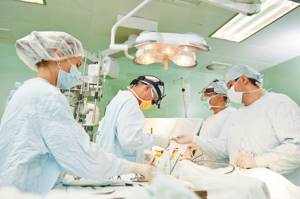
The course of a fairly mild postoperative period is still associated with a number of restrictions that the patient must comply with. These recommendations include:
- cancel physical activity for a period of 2-3 weeks;
- reduce stress on the facial muscles as much as possible;
- to avoid excessive swelling, you should sleep on your back, placing a high pillow under your head;
- do not stay in water for a long time, do not visit saunas.
In addition, some restrictions apply to the patient’s diet during the rehabilitation period:
- for the first three days, the patient limits himself to exclusively liquid nutrition, which eliminates the possibility of injury to the inner surface of the cheeks where the sutures are located;
- for the next 2-3 weeks, you need to exclude too solid foods from your diet, thereby eliminating excessive muscle strain;
- Do not injure the oral cavity with too hot or cold food and drinks.
In addition, you should pay special attention to oral hygiene after meals and follow doctor's recommendations for taking anti-inflammatory drugs.
The results of surgical removal of Bisha's fatty lumps and processes can be noticed only after the end of the rehabilitation period, but it is recommended to fully evaluate them after 4-6 months, when the damaged tissues have finally healed and the face has taken a permanent shape.

Exercise

Exercise is important not only for weight control, but also for overall health. If you want to get rid of belly fat, you shouldn't focus on ab workouts. Studies confirm Extraction and localization by electron microscopy of an immunosuppressor fraction from Mycobacterium bovis Bacillus Calmette-Guérin (BCG). that local fat burning does not exist, crunches do not affect the volume of the abdomen in any way.
But walking, running, swimming and other aerobic exercises are effective. The Effect of Exercise on Visceral Adipose Tissue in Overweight Adults: A Systematic Review and Meta-Analysis. fight fat in the waist area. They also help prevent Exercise training prevents regain of visceral fat for 1-year following weight loss. weight gain in the future. At the same time, training reduces inflammation, lowers blood sugar and minimizes The effect of exercise training on clinical outcomes in patients with the metabolic syndrome: a systematic review and meta-analysis. metabolic disorders.
Possible complications and negative consequences
After removal of Bisha's lumps, the risk of complications is quite low. However, in some cases the consequences can be extremely negative. These include:
- the development of an inflammatory process in the area of the internal tissues of the cheeks (occurs if there were hidden foci of inflammation in the body or the tissues of the mucous membrane were injured, for example, in the process of eating solid food);
- damage to the facial nerves;
- facial asymmetry, which develops in cases where fat formations were removed unevenly, for example, by the hands of an inexperienced specialist.
In the latter case, a new plastic surgery will be required in order to achieve a uniform effect. If the nerve endings in the facial area are damaged, this complication is extremely difficult to treat and is most often irreversible.
We looked at the anatomy of Bisha's fatty lumps and the features of the procedure for their removal.
Watch what you eat
Many people have no idea what or how much they eat, and tend to underestimate or overestimate the total caloric content of the diet and its macronutrient content. To change this situation, you will have to weigh all products. Maybe not for the rest of your life, but at least from time to time.
If you don't measure your portions and record the amount of calories, proteins, fats, and carbohydrates, then you simply won't be able to increase your protein intake to 25-30% of your total calories. All you need to control your diet is a kitchen scale, an app to record your results, and a simple formula for calculating calories in complex dishes.
Cost of surgery to remove lumps. Current prices
The patient's costs, as a rule, are directly related to the amount of fat removed, the technology used by the specialist and the chosen method of pain relief. Average prices for removing lumps in Moscow range between 25 and 50 thousand. As with other types of operations, this figure may increase. It all depends on the prestige of the clinic and the position of the chosen surgeon.
Despite the fact that this type of operation is considered elementary, it is better not to save on it. After all, all actions carried out during the operation are carried out very close to the facial nerves. And therefore, a poorly qualified surgeon can unintentionally hurt them.
In addition, there are situations where fat from the cheeks was removed irregularly. As a result, the face looked asymmetrical.




